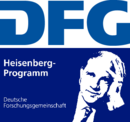»Scenography: Epistemes and aesthetic productivity in contemporary arts«
DFG Research project within the Heisenberg Programme
 Director/initiator: Birgit Wiens
Director/initiator: Birgit Wiens
Assistant: Ulrike Geiger
Host: LMU Munich/Department of Arts Studies/TWM (Theatre Studies Munich)
As a mise-en-scene and production of space, scenography appears in contemporary theatre – including other arts as well as everyday contexts – in many guises. Its spectrum ranges from stage design and theatre scenography, performance design and ›environmental scenography‹ through museum and exhibition scenography, film and media scenography to ›urban scenography‹, spatial design and the scenography of commercially orientated events. According to the thematic starting point of this project, contemporary scenography must in this regard be seen as an interdisciplinary arts phenomenon that develops its generative forms, parameters and manifestations in various fields; not least because, as a result of the increasingly apparent, pervasive influence of the media in almost all parts of life, its varieties have since become far-reaching and have gained a cultural relevance that requires academic discussion and analysis.
Premises, status of the research, project goal
The project focuses on ›stage design‹ and ›scenography‹ as an artistic practice and examines their significance, the ways in which they manifest themselves and approaches that comprehend stage design and scenography as a generally autonomous art form – both within the collaborative art form of theatre (cf. for example Bert Neumann’s frequently expressed postulate that, even at the theatre, he doesn’t act as an »outfitter« subordinate to the director but rather as a ›visual artist‹). Using these new observations, observable aesthetics should be examined, as well as that which, in the words of Patrice Pavis, can be described as ›scenographic knowledge‹. According to Pavis, scenography is an art that can simultaneously be defined as a »science of the organisation of the stage and stage area« (Pavis 2007: 969). In this way, Pavis states, it operates as an ›apparatus‹ (dispositif) (id. 1996: 315) that absorbs and binds with knowledge (especially a changing knowledge of space), institutional rules, space-creating practices, (cultural) techniques and media, while continually revising this knowledge. Scenography must therefore be analysed as an aesthetic discourse and, according to Foucault (1970), also as an element of a »history of thought systems«.
As a research topic, scenography, in accordance with its history and tradition, largely straddles the border between theatre and art studies; however, in the academic discourse, it has long been relatively ignored. Therefore, an analysis under the auspices of theatre studies, related to performance, focuses primarily on the actors, singers, dancers and performers involved as well as the »feedback loop« between them and the audience (Fischer-Lichte 2004). In addition, with regard to arts studies, the examination of aesthetics as well as epistemes of scenography beyond existing approaches (cf. Bohn/Wilharm 2009, for example) has yet to be achieved, because, as an ›applied‹ art dependent on events (which is how scenography manifests itself) it also has yet to examined. In contrast, this project operates on the assumption of a change in perspective: It will take up on the challenge (set by artists such as Bert Neumann or Katrin Brack or, in a different way, by Heiner Goebbels) to understand scenographic space, the elements of the stage, its media and the objects that appear there not as fittings or even only as background and décor, but also as equal ›actors‹, ›co-players‹ or ›counter-players‹ (cf. Goebbels 2012, Brueckner 2010). In other words, scenography manifests itself according to this definition not in ›stage sets‹ (representational, intended as static), but rather according to conceptual thinking that configures media, scenographic objects and acting options in order to »orchestrate« them in in aesthetic processes and performative, usually multimedia events (cf. McKinney/Butterworth, 2009, 7). The consequence of this perspective is that, on the level of performance or events, the presence of media, things and (human) performers – or, in the words of Bruno Latour, by human and non-human actors (cf. id. 1995, 2007, 2010) – should be regarded within the context of a symmetrical relation. Accordingly – on the level of design, project development and rehearsal – scenographic drafting and choreography/movement design should be seen as interwoven, interdependent concepts. In research, substantial gaps exist here – particularly in theatre studies, for the reasons mentioned above – that impinge on questions of sensory perception and aesthetic response as well as questions regarding the aesthetics of production, with the latter – according to a concept of scenography used in this process-orientated way – nevertheless deserving particular attention. This project takes on the challenge of this dearth in research, particularly by organising a conference that will, according to the premises outlined here, place the issues of the production aesthetics of scenography at centre stage for the first time.

